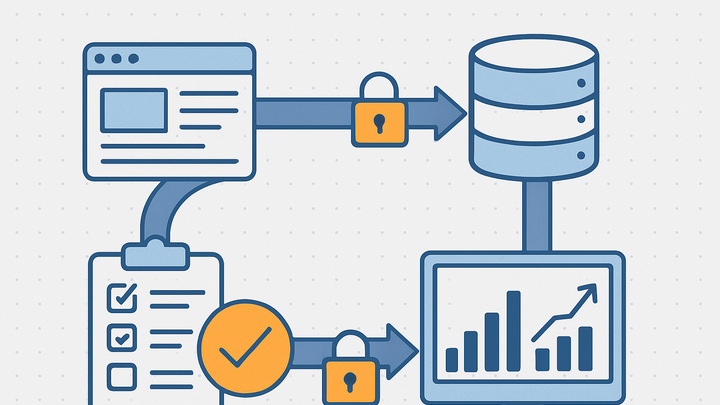Published on 2025-06-28T13:49:57Z
What is Data Integrity in Analytics? Examples for Data Integrity
Data integrity in analytics ensures that data collected, processed, and reported remains accurate, consistent, and reliable throughout its lifecycle. Without robust data integrity practices, insights derived from analytics platforms can be misleading, leading to poor decision-making and strategic missteps. It covers validation at the point of collection, secure transmission, proper storage, and ongoing monitoring of data flows. Platforms like PlainSignal and Google Analytics 4 (GA4) offer features such as cookie-free tracking, data validation rules, and audit logs to support data integrity. It also involves detecting anomalies, preventing corruption, and ensuring changes are authorized and tracked. Strong data integrity practices form the backbone of effective analytics operations and build trust across stakeholders.
Data integrity
Ensuring the accuracy, consistency, and reliability of analytics data from collection to reporting.
Why Data Integrity Matters in Analytics
Data integrity is critical to ensuring that all decisions based on analytics data are sound and trustworthy. Without it, organizations risk making choices based on incomplete or incorrect information. This section explores why maintaining data integrity underpins effective analytics and positive business outcomes.
-
Accurate decision-making
High data integrity ensures that insights and recommendations are based on precise, unaltered data, reducing the risk of strategic errors.
-
Regulatory compliance
Many industries must comply with data protection standards (e.g., GDPR, CCPA). Ensuring data integrity helps meet legal and audit requirements.
-
Operational efficiency
Reliable data prevents wasted efforts on correcting errors, enabling teams to focus on analysis rather than data cleansing.
-
Stakeholder trust
Consistent and accurate reporting builds confidence among executives, investors, and customers.
Common Challenges Affecting Data Integrity
Several factors can compromise the integrity of analytics data. Identifying these challenges is the first step toward implementing robust solutions.
-
Tracking misconfiguration
Errors in tagging or missing tags can lead to incomplete or inaccurate data capture. For example, forgetting to deploy the analytics snippet on key pages.
-
Ad blockers and privacy tools
Users’ browser extensions or privacy settings may block analytics scripts, causing underreporting. Cookie-free solutions like PlainSignal can mitigate this issue.
-
Data transmission errors
Network issues or script failures can interrupt data collection pipelines, resulting in gaps.
-
Sampling and aggregation
Some platforms, like GA4, may sample data when processing large volumes, which can affect precision for high-traffic sites.
Strategies to Ensure Data Integrity
Implementing best practices and leveraging platform features can help maintain data integrity across the analytics lifecycle.
-
Rigorous tag management
Use a tag management system (e.g., Google Tag Manager) to standardize and control analytics snippets. Validate tags with preview and debugging tools.
-
Automated testing
Set up tests to verify that tags fire correctly on intended pages and events.
-
Version control
Track changes in tag configurations to rollback problematic updates.
-
-
Data validation and auditing
Establish rules to check for anomalies, such as sudden spikes or missing data. Conduct regular audits comparing raw logs with reported metrics.
-
Threshold alerts
Configure alerts when key metrics deviate beyond expected ranges.
-
Log analysis
Review server or proxy logs to cross-verify analytics hits.
-
-
Server-side tracking
Supplement client-side tags with server-side endpoints to reduce data loss from ad blockers and connection issues.
-
Implement robust data governance
Define clear roles, processes, and documentation for data collection, processing, and maintenance to minimize human error.
Examples: PlainSignal and GA4 Implementations
Practical examples demonstrating how to deploy tracking for data integrity using both PlainSignal and Google Analytics 4.
-
PlainSignal implementation
Insert the PlainSignal tracking snippet in your site’s <head> to enable cookie-free analytics with built-in data integrity features:
<link rel="preconnect" href="//eu.plainsignal.com/" crossorigin /> <script defer data-do="yourwebsitedomain.com" data-id="0GQV1xmtzQQ" data-api="//eu.plainsignal.com" src="//cdn.plainsignal.com/plainsignal-min.js"></script> -
GA4 implementation
Use the GA4 global site tag to collect analytics data, then configure data streams and validation:
<!-- Global site tag (gtag.js) --> <script async src="https://www.googletagmanager.com/gtag/js?id=G-XXXXXXXXXX"></script> <script> window.dataLayer = window.dataLayer || []; function gtag(){dataLayer.push(arguments);} gtag('js', new Date()); gtag('config', 'G-XXXXXXXXXX'); </script>
